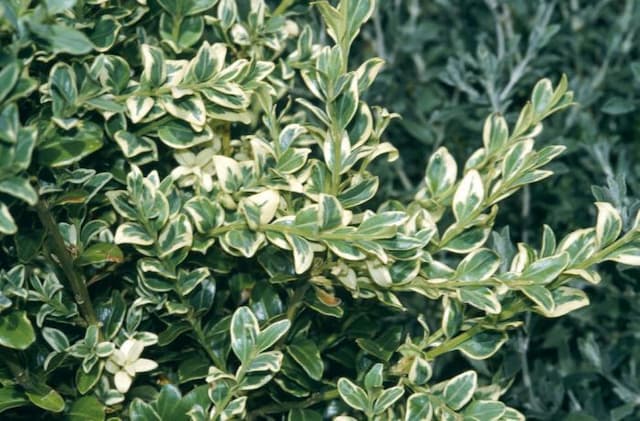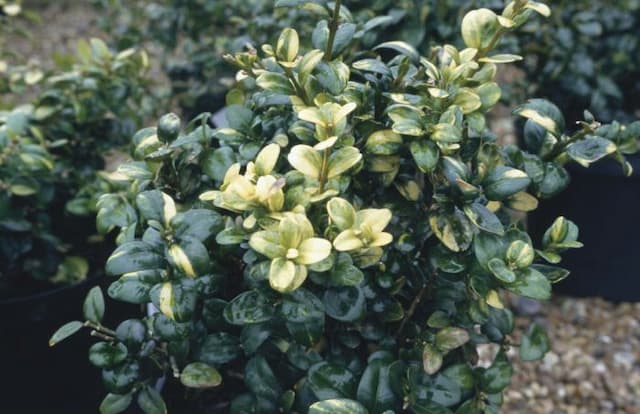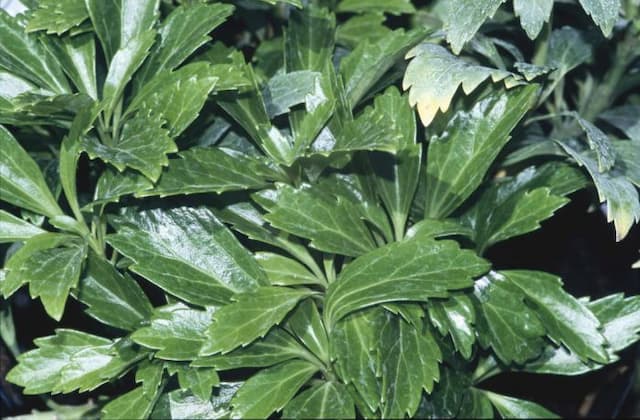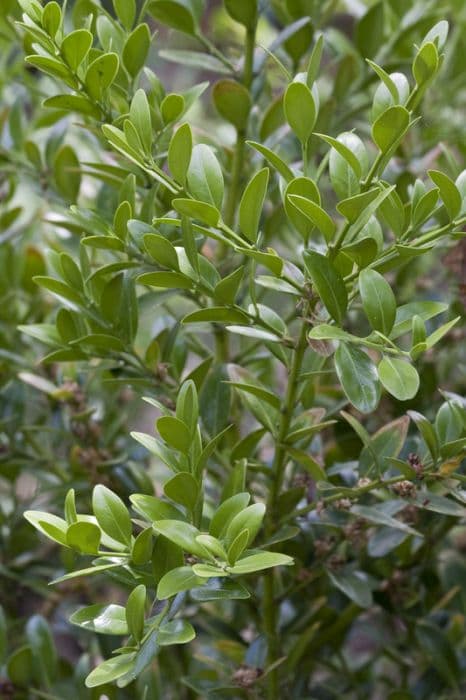Japanese spurge 'Green Sheen' Pachysandra terminalis 'Green Sheen'

ABOUT
'Green Sheen' is an evergreen sub-shrub forming a mat to 15cm in height, of very glossy, dark green, coarsely toothed, obovate leaves to 7cm in length, with erect spikes of small, white flowers in early summer
About this plant
 Names
NamesFamily
Buxaceae
Synonyms
Japanese Spurge, Green Carpet, Green Sheen Pachysandra
Common names
Pachysandra terminalis 'Green Carpet', Pachysandra terminalis 'Green Sheen'.
 Characteristics
CharacteristicsLife cycle
Perennials
Foliage type
Evergreen
Color of leaves
Green
Flower color
White
Height
6-10 inches (15-25 cm)
Spread
1-3 feet (30-90 cm)
Plant type
Shrub
Hardiness zones
4-9
Native area
Japan
Benefits
 General Benefits
General Benefits- Evergreen Ground Cover: Pachysandra provides a lush, green carpet that lasts year-round, offering a continuous display even in winter months.
- Shade Tolerance: This plant thrives in shady areas where other plants struggle, making it ideal for wooded landscapes and garden spots with little sunlight.
- Drought Resistance: Once established, Japanese Spurge can tolerate periods of drought, making it a low-maintenance option for various gardens.
- Erosion Control: The dense mat of foliage and roots helps protect soil from erosion, especially on slopes or in areas prone to water runoff.
- Low Maintenance: Japanese Spurge requires minimal care, with little need for pruning, deadheading, or frequent watering.
- Disease and Pest Resistance: Generally, it is resistant to common diseases and pests, reducing the need for chemical treatments.
- Deer Resistant: It is not a preferred food source for deer, so it often remains undamaged in areas with deer populations.
- Rapid Growth: Pachysandra spreads quickly, filling in areas and providing a full ground cover in a relatively short amount of time.
 Medical Properties
Medical Properties Air-purifying Qualities
Air-purifying QualitiesThis plant is not specifically known for air purifying qualities.
 Other Uses
Other Uses- Ground cover for erosion control: Pachysandra terminalis 'Green Sheen' can be utilized on slopes and areas prone to soil erosion due to its dense network of roots that helps stabilize the soil.
- Design element in Japanese gardens: This plant is often used in Japanese garden design for its aesthetic foliage and ability to create a serene, green carpet that complements the minimalist style.
- Filler for shaded areas in floral arrangements: Its glossy leaves can be used as a filler in floral arrangements, particularly for those that are designed to remain in shaded areas during events.
- Backdrop for spring flowering bulbs: Pachysandra can serve as a lush, green backdrop in gardens for highlighting colorful spring bulbs such as daffodils and tulips.
- Visual transition between different garden areas: Gardeners may use it to create a visual transition that smoothly blends various sections of a landscape together.
- Maze or labyrinth designs: Pachysandra can be planted in patterns to form low hedges for maze or labyrinth designs in large gardens and parks.
- Live mulch for moisture retention: Planting Pachysandra closely can act as a living mulch to help retain moisture for adjacent plants that enjoy similar shady and moist conditions.
- Base plant in container gardens: It can be used as a base plant in large container gardens to fill in around taller, more decorative plants.
- Cover for unsightly ground fixtures: Pachysandra is ideal for camouflaging ground level utility boxes, pipes, and other eyesores in the garden.
- Foot traffic barrier: In low traffic areas, Pachysandra can act as a soft barrier that discourages foot traffic while still allowing passage if needed.
Interesting Facts
 Feng Shui
Feng ShuiThe Pachysandra is not used in Feng Shui practice.
 Zodiac Sign Compitability
Zodiac Sign CompitabilityThe Pachysandra is not used in astrology practice.
 Plant Symbolism
Plant Symbolism- Peace and Tranquility: Pachysandra, also known as Japanese Spurge, often symbolizes peace and tranquility due to its lush, evergreen nature, creating serene ground cover in gardens.
- Endurance: As a hardy perennial, Pachysandra represents endurance and the ability to thrive in challenging conditions.
- Prosperity: The plant's vigorous growth and spreading habit can symbolize prosperity and the spreading of wealth.
- Cover and Protection: Given its use as ground cover, Pachysandra can also represent providing protection and shelter.
 Water
WaterJapanese Spurge thrives best with consistent moisture, especially in well-drained soils. Generally, water the plant thoroughly once a week with approximately 1 gallon of water per 10 square feet. During periods of extreme heat or drought, watering frequency may need to increase, possibly to twice a week. Conversely, reduce the watering during cooler or rainy periods to prevent waterlogging. Always check the soil moisture before watering to ensure it’s not already saturated.
 Light
LightJapanese Spurge is a shade-loving plant and does best in partial to full shade. It's ideal to place it in a spot that avoids direct afternoon sunlight, which can be too intense for this ground cover. The best lighting condition for Japanese Spurge is dappled light or areas shaded by trees or buildings.
 Temperature
TemperatureJapanese Spurge is hardy and can tolerate a wide range of temperatures, generally surviving in a range from 0 to 80 degrees Fahrenheit. The ideal temperature for this ground cover is between 50 and 70 degrees Fahrenheit where it thrives. Prolonged exposure to temperatures below 0 degrees Fahrenheit may damage the plant, while it can also struggle with heat stress above 80 degrees Fahrenheit.
 Pruning
PruningJapanese Spurge benefits from occasional pruning to remove any yellowed or damaged leaves and to rejuvenate the plant. Trimming it back in late winter or early spring before new growth begins can promote a denser habit and healthier foliage. Prune it lightly every 2-3 years or as needed to maintain its appearance and prevent overgrowth.
 Cleaning
CleaningAs needed
 Soil
SoilJapanese Spurge thrives best in a well-drained, rich organic soil mix with a pH between 5.5 and 6.5. An ideal soil mixture can be created with equal parts of garden soil, peat moss, and perlite to ensure proper moisture retention and aeration. Adjust pH accordingly if necessary.
 Repotting
RepottingJapanese Spurge is typically grown as a ground cover and rarely needs repotting. If grown in containers, repotting should be done every 2 to 3 years in spring or as the plant outgrows its pot.
 Humidity & Misting
Humidity & MistingJapanese Spurge prefers moderate to high humidity levels but is quite adaptable to average humidity conditions found in most outdoor environments.
 Suitable locations
Suitable locationsIndoor
Provide shade, water regularly, use humidifier if dry.
Outdoor
Plant in shade to part shade; keep soil moist.
Hardiness zone
4-9 USDA
 Life cycle
Life cyclePachysandra terminalis 'Green Sheen', commonly known as Japanese Spurge, begins its life cycle when seeds germinate or vegetative cuttings root in the soil during spring or early summer. The seedlings establish themselves and grow into a dense mat of evergreen foliage, thanks to its rhizomatous nature that allows for spreading. As the plants mature, they produce small, insignificant white flowers on spikes in early spring, which may develop into small, inedible fruits. Throughout the growing season, Green Sheen continues to spread and may become more glossy and vibrant. In fall and winter, growth slows down, and the plant remains mostly dormant, although it is an evergreen and retains its leaves during these colder months. Over time, as the plant becomes older, it will maintain its coverage through vegetative growth rather than relying on seed propagation.
 Propogation
PropogationPropogation time
Spring to summer
Propogation: Pachysandra terminalis 'Green Sheen', commonly known as Japanese Spurge, is propagated primarily through division, which is the most popular method. The ideal time for dividing this plant is in early spring or fall when the plant is not in active growth. To propagate by division, gently dig up a clump of the plant with a garden spade, ensuring to get a good portion of the roots. Then, using your hands or a knife, carefully separate the clump into smaller sections, each with several shoots and a healthy root system. These sections can be immediately replanted in prepared soil, placed at the same depth they were originally growing, and spaced about 6 to 12 inches (approx. 15 to 30 centimeters) apart to allow for spread and growth. Water the new plantings well and maintain consistent moisture until they become established. This method of propagation is efficient and helps to maintain the lush appearance and vigor of the ground cover.









